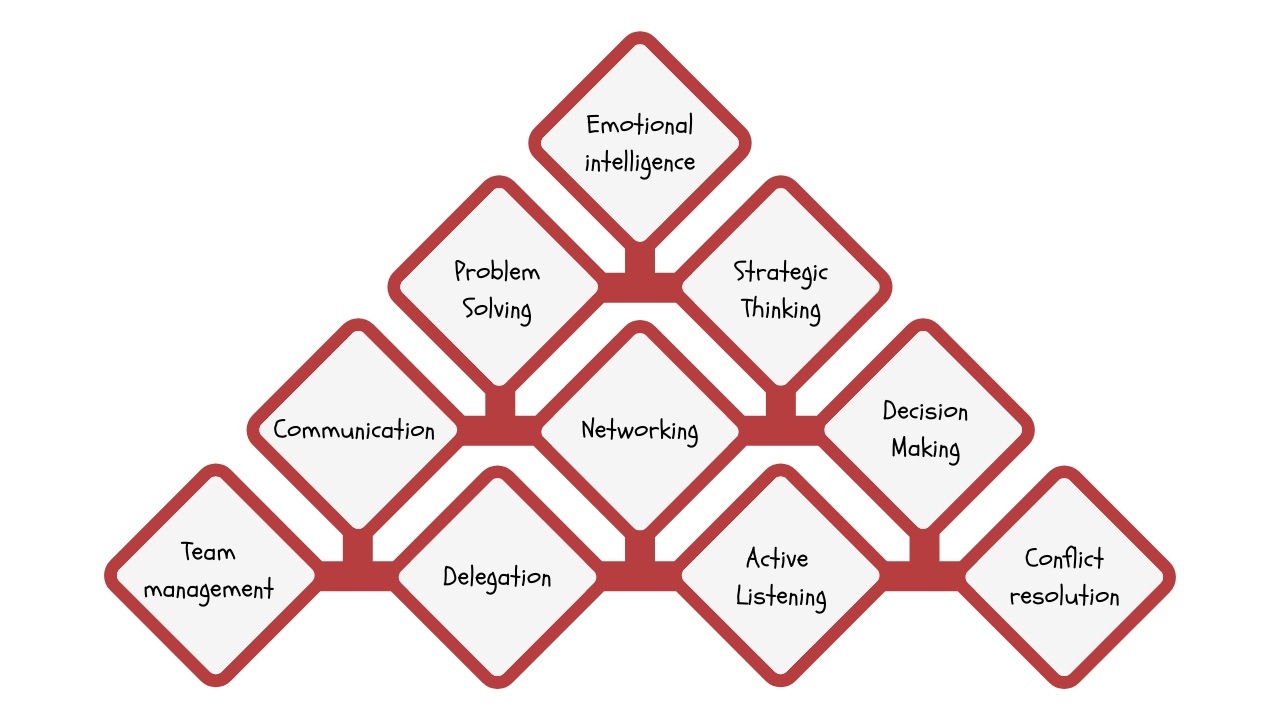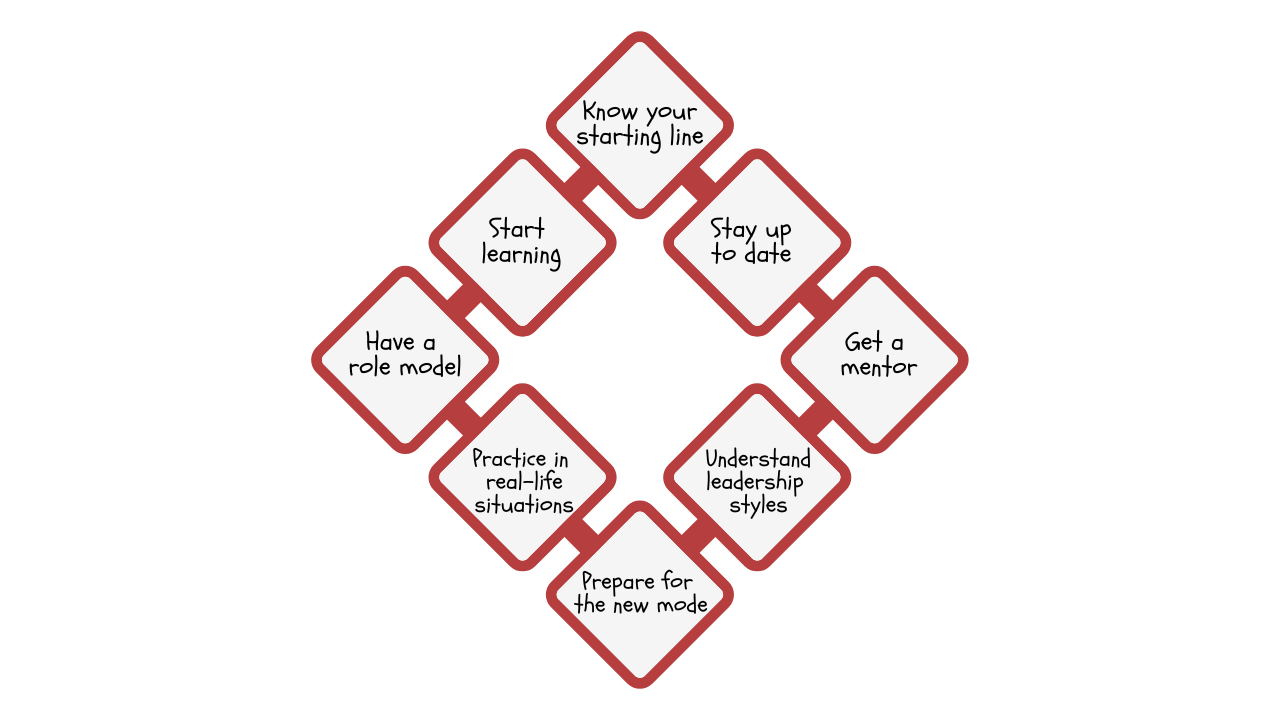It’s one hundred percent possible to get a leadership position coming from a technical background. What does it take? Just a bunch of soft leadership skills, and you can qualify for a lead role.
Soft leadership skills and competencies you need
A lead role requires a specific skill set, mostly soft skills. And these skills can be mastered. So jump into this journey with an open heart and the mantra that you can learn it.
Leadership skills and behaviors revolve around people: how you treat them, encourage them, uplift them, advocate for them, and motivate them to work.
If your social anxiety is kicking in while reading this, or the introvert in you is shouting a no, don’t step back. Introverts make great leaders due to their observant nature, strategic thinking, and rationality. Speaking less is not equal to low confidence. These two are separate things.

Let’s explore 10 soft leadership skills that you, as a data person, will need to build for the lead role.
1. Emotional intelligence
Emotional intelligence is one of the most important qualities of a leader. You must have seen your leaders handling heated arguments and talking their way out of them. This requires emotional intelligence. Don’t react, take your time to analyze the situation, and then respond.
2. Problem-solving
A leader is solution-oriented. Your team will come to you with problems, and your task will be to find a solution. You might face challenges with resources and implementation; this is where your technical skills, combined with problem-solving, will come in handy.
3. Strategic thinking
As a leader, you’ll be one of the decision-makers. You’ll see the big picture and will have to strategically align your department with it.

4. Communication
This one requires no context. We all know how important communication is. All those difficult conversations, negotiations, and feedback you see your lead handle, that’s what you, as a leader, will have to tackle daily. Here is a detailed guide on Communication for Engineers.
5. Networking
Leaders usually have a strong network within their industry. That’s how they stay up-to-date with new innovations and trends. And even if you’re an introvert, with practice you can master this skill.

6. Decision making
You need to be decisive. You’ll make critical decisions that will impact the company. If you come from a technical background, making data-backed decisions won’t be difficult. But sometimes you might not have enough data. You’ll need to use your industry knowledge and trust your instinct to make a decision.
7. Team management
This umbrella term covers everything involved in leading your team, from cultivating their skills and offering guidance to motivating them, building strong connections, recognizing their strengths, assigning tasks accordingly, and ensuring smooth collaboration.
This aspect heavily relies on your interpersonal skills.

8. Delegation
This again involves your ability to detect what others are good at. A leader is not involved in the hands-on tasks; instead, they delegate to the right person ensuring everyone plays on their strengths.
9. Active Listening
A leader will never understand their team’s point of view if they don’t actively listen. A good way to practice this is to ask your team’s opinion before pouring in yours.
You’ll make the final decision, but giving everyone a chance to talk will make them feel valued and seen.
10. Conflict resolution
This is an essential skill in leadership. Conflicts are normal. But a leader is expected to act maturely, listen to both parties, and take an action that minimizes the discourse yet maintains integrity and professionalism.
How to build leadership skills: The practical approach
Coming from a tech background, your focus should be on building soft leadership skills. Here’s an organized and structured approach to slowly learn leadership skills and pave your path towards the role.

1. Know your starting line
Start with self-awareness. Sit down and think where you’re standing in terms of leadership skills. Understand your strengths and weaknesses.
For a tech person, your strengths can be problem-solving, strategic thinking, and data-driven decision-making. You might need to polish your soft skills, including communication, the ability to inspire and motivate others, conflict resolution, and networking.
2. Start learning
Once you know what to work on, move towards learning. Check if your company offers any training sessions. You can also pick up free resources available on the internet. YouTube videos, podcasts, and books can be a good option, but go for courses if you want a structured learning route.

3. Stay up to date
A leader isn’t a part of technical execution, though they should be an expert in their field. You will use your expertise to guide others and solve technical problems, so sharpen your hard skills and stay up-to-date with industry knowledge.
4. Have a role model
If there’s someone you look up to, your leadership journey can be smoother. Observe your role model, study their behavior, and look at how they navigate difficult conversations. Note how they operate as a leader and mirror those characteristics. If possible, you can also ask them for guidance.
5. Get a mentor
If you cannot find any role model, or there’s no one in reach to guide you, you can get a mentor. The path to self-learning is a zig-zag road with steep curves, but with a mentor, you walk on a straight path and move through your leadership journey in an organized and planned manner.
If you’re a data professional who is ready to lead but not sure how to prepare for it, you can benefit from my 8-week personalized mentorship program. This is where you get one-on-one with me and we navigate your leadership journey step-by-step until you’re confident to lead.

6. Practice in real-life situations and reflect
Once you start building your leadership skills, put them to use. Start taking small opportunities in your job to practice and showcase your leadership skills, and trust me, these opportunities are all around you.
When discussing a problem, offer solutions and strategies. Instead of staying behind the scenes, start appearing on the front line of work. If you face a critical situation, don’t be impulsive; act rationally.
Reflect on the situation and your actions later. Observe what went right and what can be improved. You can ask a co-worker for feedback as well. This skill showcase will start building your foundation for leadership. When you apply for the role, it will come as no surprise.
7. Understand leadership styles
One thing that will help you adapt the right personality for your specific department is knowing your leadership style. There are multiple leadership models, and each suits a certain set of requirements.
For example, a tech leader will be authoritarian, while a creative leader will follow a laissez-faire or delegative style of leadership to promote creativity.
8. Prepare for the new mode of work: The remote work
Let’s not forget the norm, the remote work. Leadership faces challenges and requires a different approach to tackle them. As an aspiring leader, you should know how to manage remote teams the right way.
I have broken down the best leadership model for remote teams in detail; you can check that out.
How are you building leadership skills?
Remember to pick one skill at a time. Learn it, practice it, and reflect on your progress. Leadership is a set of mostly soft skills that can be learned.
So, how are you planning to learn this new set of skills? Self-learning or mentorship? If you’re not sure if this mentorship program is right for you, book a free call with me, and we will find the solution that best suits you.









